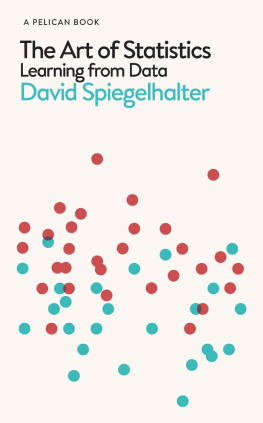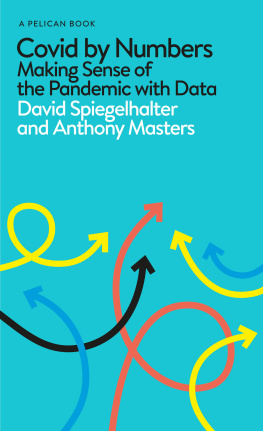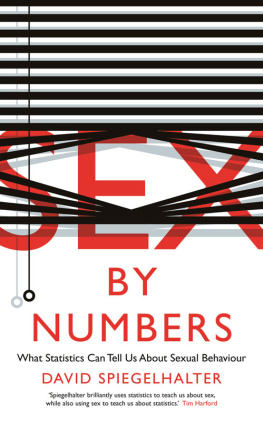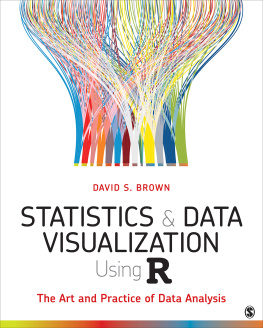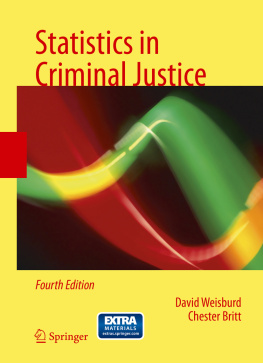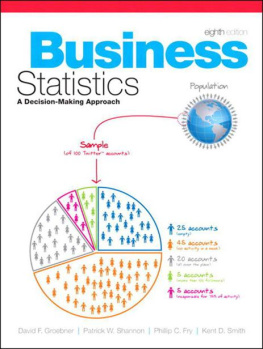David Spiegelhalter - The Art of Statistics
Here you can read online David Spiegelhalter - The Art of Statistics full text of the book (entire story) in english for free. Download pdf and epub, get meaning, cover and reviews about this ebook. year: 2019, publisher: Basic Books, genre: Children. Description of the work, (preface) as well as reviews are available. Best literature library LitArk.com created for fans of good reading and offers a wide selection of genres:
Romance novel
Science fiction
Adventure
Detective
Science
History
Home and family
Prose
Art
Politics
Computer
Non-fiction
Religion
Business
Children
Humor
Choose a favorite category and find really read worthwhile books. Enjoy immersion in the world of imagination, feel the emotions of the characters or learn something new for yourself, make an fascinating discovery.

- Book:The Art of Statistics
- Author:
- Publisher:Basic Books
- Genre:
- Year:2019
- Rating:5 / 5
- Favourites:Add to favourites
- Your mark:
- 100
- 1
- 2
- 3
- 4
- 5
The Art of Statistics: summary, description and annotation
We offer to read an annotation, description, summary or preface (depends on what the author of the book "The Art of Statistics" wrote himself). If you haven't found the necessary information about the book — write in the comments, we will try to find it.
The Art of Statistics — read online for free the complete book (whole text) full work
Below is the text of the book, divided by pages. System saving the place of the last page read, allows you to conveniently read the book "The Art of Statistics" online for free, without having to search again every time where you left off. Put a bookmark, and you can go to the page where you finished reading at any time.
Font size:
Interval:
Bookmark:

Copyright 2019 by David Spiegelhalter
Cover design by Chin-Yee Lai
Cover image by IAISI/Getty Images
Cover copyright 2019 Hachette Book Group, Inc.
Hachette Book Group supports the right to free expression and the value of copyright. The purpose of copyright is to encourage writers and artists to produce the creative works that enrich our culture.
The scanning, uploading, and distribution of this book without permission is a theft of the authors intellectual property. If you would like permission to use material from the book (other than for review purposes), please contact permissions@hbgusa.com. Thank you for your support of the authors rights.
Basic Books
Hachette Book Group
1290 Avenue of the Americas, New York, NY 10104
www.basicbooks.com
Originally published in March 2019 by Pelican, an imprint of Penguin Books, in the United Kingdom
First US Edition: September 2019
Published by Basic Books, an imprint of Perseus Books, LLC, a subsidiary of Hachette Book Group, Inc. The Basic Books name and logo is a trademark of the Hachette Book Group.
The Hachette Speakers Bureau provides a wide range of authors for speaking events. To find out more, go to www.hachettespeakersbureau.com or call (866) 376-6591.
The publisher is not responsible for websites (or their content) that are not owned by the publisher.
Library of Congress Control Number: 2019944285
ISBNs: 978-1-5416-1851-0 (hardcover); 978-1-5416-1852-7 (ebook)
E3-20190806-JV-NF-ORI
CHAPTER 1
Getting Things in Proportion: Categorical Data and Percentages
CHAPTER 2
Summarizing and Communicating Numbers. Lots of Numbers
CHAPTER 3
Why Are We Looking at Data Anyway? Populations and Measurement
CHAPTER 4
What Causes What?
CHAPTER 5
Modelling Relationships Using Regression
CHAPTER 6
Algorithms, Analytics and Prediction
CHAPTER 7
How Sure Can We Be About What Is Going On? Estimates and Intervals
CHAPTER 8
Probabilitythe Language of Uncertainty and Variability
CHAPTER 9
Putting Probability and Statistics Together
CHAPTER 10
Answering Questions and Claiming Discoveries
CHAPTER 11
Learning from Experience the Bayesian Way
CHAPTER 12
How Things Go Wrong
CHAPTER 13
How We Can Do Statistics Better
CHAPTER 14
In Conclusion
To statisticians everywhere, with their endearing traits of pedantry, generosity, integrity, and desire to use data in the best way possible
Explore book giveaways, sneak peeks, deals, and more.

Any insights gained from a long career in statistics come from listening to inspiring colleagues. These are too numerous even for a statistician to count, but a shortlist of those I have stolen most from might include Nicky Best, Sheila Bird, David Cox, Philip Dawid, Stephen Evans, Andrew Gelman, Tim Harford, Kevin McConway, Wayne Oldford, Sylvia Richardson, Hetan Shah, Adrian Smith and Chris Wild. I am grateful to them and so many others for encouraging me in a challenging subject.
This book has been a long time in development, entirely due to my chronic procrastination. So I would primarily like to thank Laura Stickney of Penguin for not only commissioning the book, but remaining calm as the months, and years, went by, even when the book was finished and we still could not agree on a title. And all credit to Jonathan Pegg for negotiating me a fine deal, Jane Birdsell for showing huge patience when editing, and all the production staff at Penguin for their meticulous work.
I am very grateful for permission to adapt illustrations, specifically Chris Wild (). UK public sector information is licensed under the Open Government Licence v3.0.
I am not a good R programmer, and Matthew Pearce and Maria Skoularidou helped me enormously in doing the analyses and graphics. I also struggle with writing, and so am indebted to numerous people who read and commented on chapters, including George Farmer, Alex Freeman, Cameron Brick, Michael Posner, Sander van der Linden and Simone Warr: in particular Julian Gilbey had a fine eye for errors and ambiguity.
Above all, I must thank Kate Bull not only for her vital comments on the text, but also for supporting me through times that have been both good (writing in a beach hut in Goa) and not so good (a wet February juggling too many commitments).
I am also profoundly grateful to David and Claudia Harding for both their financial support and their continued encouragement, which has enabled me to do such fun things over the last ten years.
Finally, much as I would like to find someone else to blame, I am afraid I must acknowledge full responsibility for the inevitable remaining inadequacies of this book.
CODE FOR EXAMPLES
R code and data for reproducing most of the analyses and Figures are available from https://github.com/dspiegel29/ArtofStatistics. I am grateful for the assistance received in preparing this material.
The numbers have no way of speaking for themselves. We speak for them. We imbue them with meaning.
Nate Silver, The Signal and the Noise
Harold Shipman was Britains most prolific convicted murderer, though he does not fit the archetypal profile of a serial killer. A mild-mannered family doctor working in a suburb of Manchester, between 1975 and 1998 he injected at least 215 of his mostly elderly patients with a massive opiate overdose. He finally made the mistake of forging the will of one of his victims so as to leave him some money: her daughter was a solicitor, suspicions were aroused, and forensic analysis of his computer showed he had been retrospectively changing patient records to make his victims appear sicker than they really were. He was well known as an enthusiastic early adopter of technology, but he was not tech-savvy enough to realize that every change he made was time-stamped (incidentally, a good example of data revealing hidden meaning).
Of his patients who had not been cremated, fifteen were exhumed and lethal levels of diamorphine, the medical form of
This book will focus on using statistical science to answer the kind of questions that arise when we want to better understand the worldsome of these questions will be highlighted in a box. In order to get some insight into Shipmans behaviour, a natural first question is:
What kind of people did Harold Shipman murder, and when did they die?
The public inquiry provided details of each victims age, gender and date of death. is a fairly sophisticated visualization of this data, showing a scatter-plot of the age of victim against their date of death, with the shading of the points indicating whether the victim was male or female. Bar-charts have been superimposed on the axes showing the pattern of ages (in 5year bands) and years.
Some conclusions can be drawn by simply taking some time to look at the figure. There are more black than white dots, and so Shipmans victims were mainly women. The bar-chart on the right of the picture shows that most of his victims were in their 70s and 80s, but looking at the scatter of points reveals that although initially they were all elderly, some younger cases crept in as the years went by. The bar-chart at the top clearly shows a gap around 1992 when there were no murders. It turned out that before that time Shipman had been working in a joint practice with other doctors but then, possibly as he felt under suspicion, he left to form a single-handed general practice. After this his activities accelerated, as demonstrated by the top bar-chart.
Font size:
Interval:
Bookmark:
Similar books «The Art of Statistics»
Look at similar books to The Art of Statistics. We have selected literature similar in name and meaning in the hope of providing readers with more options to find new, interesting, not yet read works.
Discussion, reviews of the book The Art of Statistics and just readers' own opinions. Leave your comments, write what you think about the work, its meaning or the main characters. Specify what exactly you liked and what you didn't like, and why you think so.

